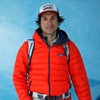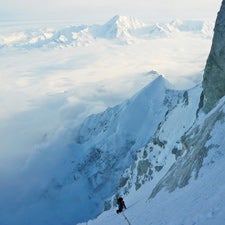KATSUTAKA YOKOYAMA AND YASUSHI OKADA
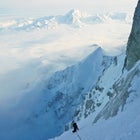 Okada follows Yokoyama up the last of the headwall at the end of day three
Okada follows Yokoyama up the last of the headwall at the end of day threeFirst Ascent of the Southeast Face of Mount Logan
It was the biggest unclimbed wall in North America: the southeast face of Mount Logan, an 8,500-foot headwall of rock, snow, and ice that had eluded alpinists for more than a decade. On May 7, 2010, Japanese climbers Katsutaka “Jumbo” Yokoyama, a 31-year-old famed for big ascents in Alaska, and Yasushi Okada, 37, completed the first ascent of the giant face in only four days.
To understand just how audacious their accomplishment was, you have to consider Mount Logan itself. At 19,550 feet in the Yukon’s St. Elias Mountains, Logan is the highest point in Canada, with a summit plateau that stretches 25 square miles. It’s the kind of topography climbers vanish into. During the 1925 first ascent of the mountain, a team of North America’s strongest alpinists nearly died in a whiteout. Altitude, isolation, cold, avalanches, cornices, and weeklong stormsÔÇöall merge to create the Logan Effect, making the mountain seem to grow as you climb it. “Logan is more Himalayan than the Himalaya,” says Canadian mountaineer Jim Elzinga, who participated in the first ascent of the mountain’s technical south-southwest buttress in 1979.
Of the several elite mountaineers who’ve attempted the face, not even Jack Tackle, a 57-year-old IdahoÔÇłclimber known for his bold routes, had made it more than 3,000 feet. In 2009, a friend showed Yokoyama a picture of the wall. The Hokutu-based JumboÔÇö five-feet-nine is tall in JapanÔÇöhad made significant ascents in the Alaska Range, but he longed to experience “the hugeness of nature” in an even less explored wilderness. He reached out to Tackle, and although the American still hoped to make another attempt at the first ascent of the face, he shared his photos from his 1999 and 2007 attempts.
On May 4, Okada and Yokoyama hurried up the lower slopes, moving in alpine style with minimal equipment and seven days’ worth of food and fuel. Although the two had never been on a big expedition together, Yokoyama knew Okada was a strong climber, with experience on India’s 20,702-foot Meru Central. The first rock band, however, proved harder than expected. On May 5, they struggled until nightfall up a long, steep chimney of thin ice and loose stone. By then they realized this route would be too dangerous to descend. Their best hope for survival, let alone success, was to keep going to the top of the wall, across the immense plateau, and down the easier East Ridge, 18 linear miles from their base camp. If a storm trapped them anywhere on this odyssey, 80 miles from the nearest permanent habitation, they’d be done. “We’re fantastic,” Okada joked. His words became their mantra for the rest of the climb.
The next day, they scratched their way up thousands more feet and crested the summit plateau, where, exhausted, they camped. They were approaching their limits. According to mountaineering tradition, you must reach one of Logan’s major subsummits to claim a true ascent.
The next morning, the two men forged through snowdrifts toward one of these, 19,357-foot East Peak. The blue sky appeared surreal. Yokoyama wondered when the famous storms might cut off their escape. Two thousand feet below the top, they foundered and agreed to turn back. But then Yokoyama sighed, and Okada responded, “It’s not right to retreat like this. We have to summit.”
Three hours later, at 1:40 p.m., they stood on top. “Our joy was beyond words,” Yokoyama later wrote. “A single thread seemed to connect all those who confronted Logan beforeÔÇöand all those who helped us. To honor them, we named the route I-To, which means ‘line-thread relationship.'” After the long descent, Yokoyama e-mailed Tackle to thank him for his help. “It is hard to give up a dream,” Tackle replied, “but I am happy it was you.”
Matt Wilson, Ryan Casey, Matt and Nate Klema, Evan Ross, and Ben Luck
First decent of the R├şo Huallaga, Peru
RÔłÜÔëáo Huallaga
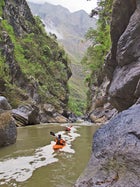 Team Beer exiting the second gorge
Team Beer exiting the second gorgeIn the past 30 years, kayakers have explored every major tributary of the Amazon except one: Peru’s Huallaga. The 300-mile canyon through the Andes had rebuffed two expeditions with its Class V whitewater, three unscoutable gorge sections, and rumors of a 150-foot waterfall. Last September, Telluride, ColoradoÔÇôbased Matt Wilson, at 33 an unsung veteran of the New Riders of the Perfect Wave film crew, which spawned kayaking greats like Seth Warren, Ben Selznick, and Nick Turner, gathered a group of five unsponsored paddlers from across the West and dubbed them Team Beer. They waited until the Huallaga was at its lowest flow and set off into the 7,000-foot-deep canyon with their kayaks, holding 12 days’ worth of food, 200 feet of climbing rope, and one sat phone. The crux came on the second day, when the Huallaga crashed though a Class V rapid and entered an unknown gorge. If the river turned unrunnable, they’d have no way to escape.
“The hardest part was committing,” says Wilson. The box canyon below was barely more than ten feet wide, but it was clean and easily navigable. The following two gorges were the sameÔÇöa Class V entrance into a beautiful, sheer-walled Class II gorge.
Much to Team Beer’s relief, the 150-foot waterfall never materialized. But on their third and final day, Wilson saw workers drilling high on the canyon wall: blast holes for the Chaglla Dam. It’s scheduled to drown the river by 2016.
“The Huallaga would have been Peru’s next classic,” says Wilson.
Hendrik Coetzee, Ben Stookesberry, and Chris Korbulic
Descents of the Congo River's Tributaries
Kayaking Congo River Tributary
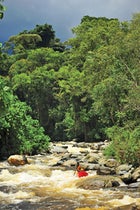
A fatal crocodile attack on South African expedition leader Hendrik Coetzee, 35, on December 7, while paddling the Congo’s Lukuga River, brought this journey to a tragic close, but not before the team had accomplished its objectivesÔÇöfirst descents of several of the Congo River’s steep upper tributaries. Along with Coetzee, American expedition-paddling veterans Ben Stookesberry, 32, and Chris Korbulic, 24, started on the border between Rwanda and the Democratic Republic of the Congo and descended the Ruzizi River, which Coetzee described on his blog, , as a perfect Class V run: “The whitewater was everything we had hoped for, rapids flowing into one another in uninterrupted continuity.” But the dangers of the Congo aren’t necessarily in the rapids, as proved true on their next river, the Lukuga, which flows out of Lake Tanganyika. After the attack, Stookesberry and Korbulic, shaken but unhurt, abandoned the expedition. They’d still like to explore other parts of Central Africa, but out of respect for Coetzee, they have no plans to return to the Lukuga. Next time, they’ll focus their efforts farther south, in Zambia. “It’s still this massive wilderness with so many huge rivers that have yet to be run,” says Stookesberry.
Alexander Martin
Inland canoe traverse of the United States
Alexander Martin
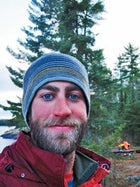
Some recent college grads backpack around Europe. “Zand” Martin wanted something a little more Lewis and Clark. So the 25-year-old borrowed a 33-pound canoe, drove it to Portland, Oregon, and on April 4, 2009, set off up the Columbia River Gorge toward homeÔÇöPortland, Maine. “I wanted to challenge the idea that you need to go to Patagonia to find adventure,” says Martin. “I liked that I was traveling through people’s backyards.” Going on his own steam save for a couple of rides he hitched, Martin paddled up the Columbia and Snake rivers before stopping in the border town of Weiser, Idaho, where he found an old cruiser bike on Craigslist for $30 that he retrofitted with a trailer made from scrap metal. After making it to Jackson, Wyoming, he turned north and began a 650-mile portage and paddle up and over the Continental Divide and down into Montana’s Yellowstone River, where he chipped away at his ice-crusted paddle before a 400-mile portage across North Dakota. Twice during the circuitous 4,000-mile affair, he paused his journey to guide wilderness-education trips for his employer, the National Outdoor Leadership School. Seven months in, he’d made it to Minnesota’s Boundary Waters Canoe Area Wilderness. “It’s supposedly the most popular canoe destination in the country, but I didn’t see anything besides wolves and ice for 16 days,” he says. “Maybe that’s because it was November.” After connecting with New Hampshire’s Androscoggin River via the Great Lakes and several Adirondack waterways, he floated down the Presumpscot River into Portland on September 25. Now he’s thinking of crossing Eurasia. “I’d like to paddle from Portugal to Nakhodka, Russia,” says Martin. “It’s something like 12,000 miles. No one has come close to doing anything like that yet.”
Edurne Pasaban
The first woman to climb all 14 8,000-meter peaks—we think
Edurne Pasaban
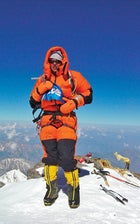 Pasaban on the summit of Pakistan's 26,660-foot Nanga Parbat in 2004
Pasaban on the summit of Pakistan's 26,660-foot Nanga Parbat in 2004Last spring, someone became the first woman to ascend all 14 of the world’s 8,000-meter peaks. Trouble is, the official ruling on who owns the title is still in dispute. Initial reports had 45-year-old Korean Oh Eun-Sun topping out on her last peak, Nepal’s 26,545-foot Annapurna, late last April. Veteran Basque mountaineer Edurne Pasaban, 37, finished up three weeks later with Tibet’s 26,289-foot Shishapangma. So what’s the issue? Controversy surrounds Oh’s May 2009 summit photos from India’s highest mountain, 28,169-foot Kanchenjunga. Several climbers, including Pasaban, who was on the peak at the same time, say they were taken 500 feet below the summit. When confronted, Oh acknowledged stopping probably a few meters short due to turbulent weather up top and taking her “summit” photos farther below. But there is no clear marker at the peak, and she insists she conquered it. Two of her Sherpas back her claims; a third says she failed in her bid. Last fall, the Korean Alpine Federation ruled that there isn’t enough evidence to validate Oh’s claim, citing the lack of true summit photos, the questionable timeline of her ascent, and her Korean flag found weighted with stones some 170 feet below the summit. Elizabeth Hawley, who has managed the Himalayan Database, climbing’s bible of ascents in the range, for more than four decades, has marked Oh’s Kanchenjunga ascent “Disputed.” But most of the international climbing community says the crown goes to Pasaban. To boot, she bagged 13 of the peaks without supplemental oxygen, which Oh used on Everest and K2. Pasaban plans to make it a solid 14 this spring with a second Everest summit, sans O2, making her the hands-down queen of the 8Ks.
Ed Stafford
First Descent of the Amazon on Foot
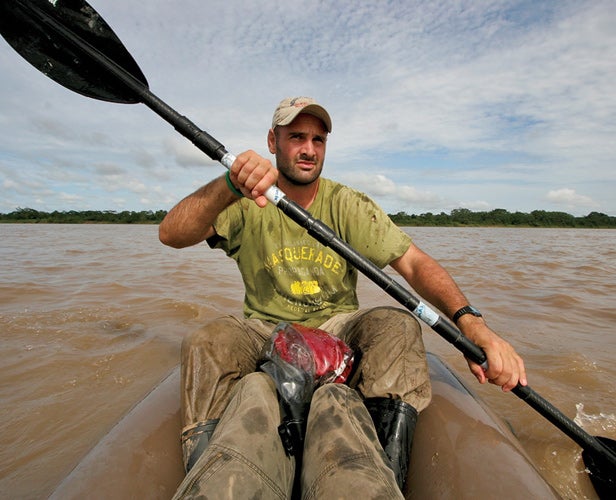
For 860 daysÔÇöthat’s two years, four months, and one weekÔÇö35-year-old former British Army captain Ed Stafford hacked his way through the South American jungle to become the first person to descend the length of the Amazon River on foot. Starting at a trickling rivulet in the Peruvian Andes, Stafford walked more than 4,000 miles downstream to the river’s mouth at the Atlantic Ocean, finishing on August 9. The hardest part of the source-to-sea expedition, however, wasn’t digging bot flies out of his scalp, digesting fried ocelot, or keeping at bay the countless parasites looking for a host. The hardest part was the mental burden of shouldering his heavy packÔÇöwhich included a raft for crossing the riverÔÇöevery morning and slogging through muddy jungle for nearly two andÔÇła half years. “It’s easy to go into the jungle for two days,”ÔÇłhe says. “A bit more of an ordeal to go for a week. But to go into jungle for two years is just ridiculous.”
Stafford, who received military training in the jungles of the Far East and Central America, saw firsthand the atrocities of tropical deforestationÔÇöthe illegal felling of old-growth mahogany, the slash-and-burn consumption of acre after jungle acre, the unchecked expansion of agriculture. So after retiring from the military in 2002 and spending several years as an expedition guide, he decided to do something about it. He packed a laptop, started a blog for schools to follow his progress, and set out for the Amazon.
But progress wasn’t always as easy as putting one foot in front of the other. Aggressive Ash├ęninka tribesmen near Atalaya, Peru, barred Stafford’s passage for three days. A cut on his arm festered and refused to heal. He got lost. He suffered malnutrition and sore feet. He collapsed on the side of the road the day before reaching the Atlantic. But in the end, uncorking a bottle of champagne on the beach was elation enough for him to plan a second expedition. Stafford heads out again in January for parts unknown. He won’t divulge what that next project is, but, he assured ║┌┴¤│ď╣¤═°, “it’s bloody difficult.”
Explorer Eric Larsen
The North Pole, the South Pole, and Everest
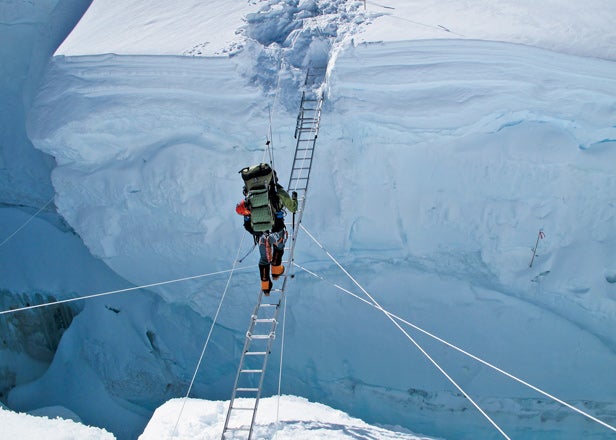
“It's cool to be cold,” says Eric Larsen. The 39-year-old explorer from Grand Marais, Minnesota,ÔÇłhas long had a love affair with the earth's most frigid placesÔÇöbut in 15 years of dog mushing, adventure racing, and exploring both poles, he's seen evidence of their rapid disappearance. That's why he devoted 365 days, from November 2009 to October 2010, to his Save the Poles project, an unprecedented single-year expedition to the polar trifectaÔÇöNorth Pole, South Pole, and Everest. Larsen hit the South Pole first, collecting scientific data, filming a documentary, and tweeting his progress, then he headed north the following March to ski, snowshoe, and swim across the Arctic in negative-50-degree temps. His mantra, “Begin with one step,” propelled him through thinning Arctic ice that bent beneath his skis and fractured around his three-man team's campsites, opening gaping holes of icy water near where they slept. From seasickness-inducing whiteouts in Antarctica to avalanches on an empty autumn Everest, Larsen and his revolving cast of teammates and Sherpas bore their share of hardships. But that wasn't the whole story. “A big part of the experience is the jaw-dropping awe that these places exist,” he says. “But it's countered with a dose of reality, because I could see that the character of the ice had changed dramatically. It's a jumble of emotions.” Witnessing firsthand the retreat of Himalayan glaciers, which supply more than half the drinking water to 40 percent of the world's population, Larsen was reminded that, though the planet's ice may be losing its integrity, we can't afford to compromise our own. “We have to take that first step to learn and practice skills for solving environmental problems,” he says. “Inaction is not an option.”
Andrew Skurka
Human-powered circumnavigation of Alaska
Andrew Skurka didn’t have many “wahoo moments,” as he calls them, while skiing, hiking, and packrafting solo across 4,680 miles of Alaska and the Yukon for 176 days last March to September. “I was basically scared for six months straight,” says the Colorado-based endurance athlete.
Petrified, yes, but not unprepared. After graduating from Duke with an economics degree in 2004, Skurka, now 30, eschewed the Wall Street track but remained loyal to risk management, embarking on a full-time career of long-distance epics like the 7,775-mile sea-to-sea trek from Quebec to Washington that he finished in 2005. “I’d consider myself the antithesis of Chris McCandless,” he says. “The spreadsheets I use to plan my trips are beautiful things.”
Most of Skurka’s National GeographicÔÇôfunded AlaskaÔÇôYukon loop had been previously explored, but never in one push. The route was a logistical monster: beginning in the tiny Arctic town of Kotzebue, he skied the Iditarod Trail and the Alaska Range until the spring snowmelt, then hiked and floated through national parks, the Yukon River, and the Brooks Range back to point A. The route was 45 percent off-trail, yet Skurka averaged 27 miles per day, despite skiing in whiteout conditions, bushwhacking in sandstorms, and paddling across wind-whipped fjords. He was joined for part of the trip by photographer Michael Christopher Brown.
During a 24-day stretch in the Yukon Arctic without seeing a road or another human being, Skurka ran smack into the migration corridor of the famed Porcupine caribou herd. “It looked like a highway across the tundra,” he said. “I felt primal, like how we must have felt 10,000 years ago when we were just another mammal.” That’s not to say his motivation for the trip was ecological; Skurka wasn’t out to save polar bears or raise awareness about the shrinking ice caps. “I’m a Massachusetts-born guy who lives in Boulder,” Skurka says. “Who am I to show up in Alaska and say they shouldn’t be drilling in ANWR?” Instead, he was driven by what he describes as “unabashed self-interest.”ÔÇłHe wanted to push the limits of bigger, faster, lighterÔÇöquite simply, “to feel alive.”

